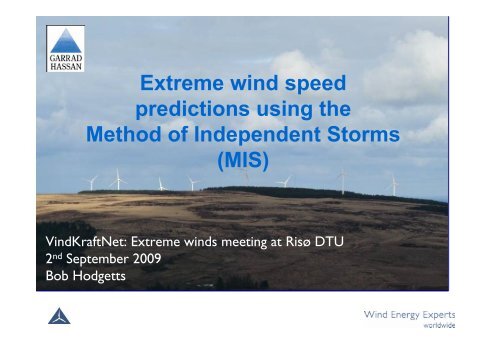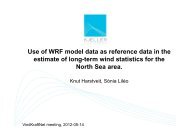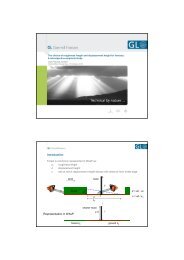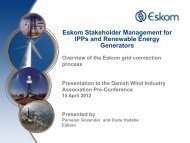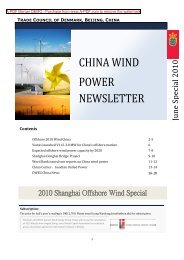Extreme wind speed predictions using the Method of Independent ...
Extreme wind speed predictions using the Method of Independent ...
Extreme wind speed predictions using the Method of Independent ...
You also want an ePaper? Increase the reach of your titles
YUMPU automatically turns print PDFs into web optimized ePapers that Google loves.
<strong>Extreme</strong> <strong>wind</strong> <strong>speed</strong><br />
<strong>predictions</strong> <strong>using</strong> <strong>the</strong><br />
<strong>Method</strong> <strong>of</strong> <strong>Independent</strong> Storms<br />
(MIS)<br />
VindKraftNet: <strong>Extreme</strong> <strong>wind</strong>s meeting at Risø DTU<br />
2 nd September 2009<br />
Bob Hodgetts
What is an MIS analysis<br />
In simple terms, a Gumbel analysis from time series data<br />
Key input:<br />
Seven years <strong>of</strong> ten-minute or hourly time series data<br />
Basics <strong>of</strong> <strong>the</strong> method:<br />
• Identify <strong>the</strong> maximum <strong>wind</strong> <strong>speed</strong>s recorded;<br />
• Ensure each maximum is from an independent storm;<br />
• Conduct a Gumbel analysis <strong>of</strong> <strong>the</strong> extreme <strong>wind</strong> <strong>speed</strong>s<br />
Result:<br />
A predicted extreme <strong>wind</strong> <strong>speed</strong> trend
Indentify independent storms<br />
40<br />
<strong>Independent</strong> storms (more than 48 hours apart)<br />
35<br />
30<br />
Mean <strong>wind</strong> <strong>speed</strong> [m/s]<br />
25<br />
20<br />
15<br />
10<br />
Storm<br />
threshold<br />
5<br />
0<br />
01/01/2009 03/01/2009 05/01/2009 07/01/2009 09/01/2009 11/01/2009 13/01/2009 15/01/2009
Example result<br />
Assumes extreme events are from <strong>the</strong> same <strong>wind</strong> mechanism
Typical MIS prediction<br />
• 2 years <strong>of</strong> on site <strong>wind</strong> measurements<br />
• Correlate to reference station with 7+ years consistent data<br />
• Predict long-term time series at site mast<br />
• Run a MIS or similar model to predict extreme <strong>wind</strong> <strong>speed</strong>,<br />
usually a ten-minute <strong>of</strong> hourly value<br />
• Analyse site gust ratio to factor ten-minute or hourly<br />
extreme to 3 second gust value<br />
Differences in MCP review compared to energy assessments<br />
Pro: Does <strong>the</strong> quality <strong>of</strong> <strong>the</strong> correlation need to be as good<br />
Con: Need 7+ years <strong>of</strong> time series data which can be expensive
MIS <strong>predictions</strong> at turbines<br />
• <strong>Extreme</strong> <strong>wind</strong> <strong>speed</strong>s predicted at masts<br />
• Long-term time series syn<strong>the</strong>sised at turbines from mast<br />
<strong>using</strong> directional <strong>speed</strong>-ups determined in <strong>wind</strong> flow model<br />
• MIS model run for each turbine<br />
• Gust ratios predicted to turbines<br />
(based on assumption <strong>of</strong> constant standard deviation <strong>of</strong> <strong>wind</strong> <strong>speed</strong>)<br />
Uncertainties will always be significant<br />
• Uncertainty in general MIS method<br />
• Correlation to reference data<br />
• Wind flow model
35%<br />
Indication <strong>of</strong> uncertainty in MIS<br />
• Seven long-term reference stations considered<br />
• Periods <strong>of</strong> consistent data from 11 to 20 years<br />
• Each station time series cut-up into lots <strong>of</strong> shorter periods and run<br />
through MIS prediction<br />
• Results are standard deviations <strong>of</strong> all results obtained about <strong>the</strong><br />
mean result for each station<br />
Standard Deviation <strong>of</strong> different results<br />
30%<br />
25%<br />
20%<br />
15%<br />
10%<br />
5%<br />
Average line<br />
0%<br />
1 year 2 years 3 years 4 years 5 years 6 years 7 years<br />
Period <strong>of</strong> data used for prediction
Thank you<br />
Any questions after today <strong>the</strong>n please get in touch:<br />
bob.hodgetts@garradhassan.com


